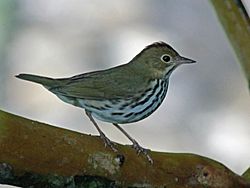Ovenbird facts for kids
Quick facts for kids Ovenbird |
|
|---|---|
 |
|
| Conservation status | |
| Scientific classification | |
| Kingdom: | |
| Phylum: | |
| Class: | |
| Order: | |
| Family: | |
| Genus: |
Seiurus
Swainson, 1827
|
| Species: |
S. aurocapilla
|
| Binomial name | |
| Seiurus aurocapilla (Linnaeus, 1766)
|
|
| Synonyms | |
|
Motacilla aurocapilla Linnaeus, 1766 |
|
The Ovenbird (Seiurus aurocapilla) is a small songbird known for its unique nest. It belongs to a group of birds called Passeriformes, which are often called "perching birds." Its family, Parulidae, includes many colorful New World warblers.
This bird gets its name from its special nest, which looks a lot like an old-fashioned outdoor oven. It's shaped like a dome with an entrance on the side. Unlike most birds in its family that hop, the Ovenbird prefers to walk along the forest floor.
Contents
Where Ovenbirds Live
Ovenbirds are migratory birds. This means they travel long distances between their summer and winter homes. During the warmer months, you can find them in the eastern parts of North America.
When winter arrives, these birds fly south to warmer places. They spend their winters in Central America, many Caribbean Islands, Florida, and northern Venezuela. They prefer forests with lots of trees and leaves on the ground.
What Ovenbirds Look Like
The Ovenbird is a medium-sized songbird, usually about 14 to 16 centimeters (5.5 to 6.3 inches) long. It has an olive-brown back and a white belly with dark streaks. One of its most noticeable features is a bright orange stripe on its head, bordered by two black stripes. This orange "cap" makes it easy to identify.
They have a short tail and a fairly thick bill. Their legs are pinkish. Males and females look very similar, so it can be hard to tell them apart just by looking.
Ovenbird Diet
Ovenbirds mostly eat insects and spiders. They are very good at finding food on the forest floor. They often flip over leaves and search under logs to find hidden bugs. Their diet includes beetles, ants, caterpillars, and other small creatures. Sometimes, especially in winter, they might also eat small seeds or berries.
Nesting and Reproduction
The Ovenbird is famous for its unique nest. It builds its nest directly on the ground, often hidden among leaves and plants. The nest is shaped like a dome or a small oven, made from leaves, twigs, and moss. It has a small opening on the side, which helps keep the eggs and chicks safe from predators.
The female bird lays about 3 to 6 eggs, which are white with brown spots. She sits on the eggs to keep them warm until they hatch, usually after about 11 to 14 days. Once the chicks hatch, both parents help feed them. The young birds grow quickly and are ready to leave the nest in about 8 to 11 days.
Ovenbird Sounds
The Ovenbird has a loud and clear song that sounds like "teacher, teacher, TEACHER!" The song gets louder and more intense with each "teacher." They sing this song to mark their territory and attract a mate. They also have a sharp "chip" call they use when they are alarmed.
Images for kids
See also
 In Spanish: Reinita hornera para niños
In Spanish: Reinita hornera para niños





